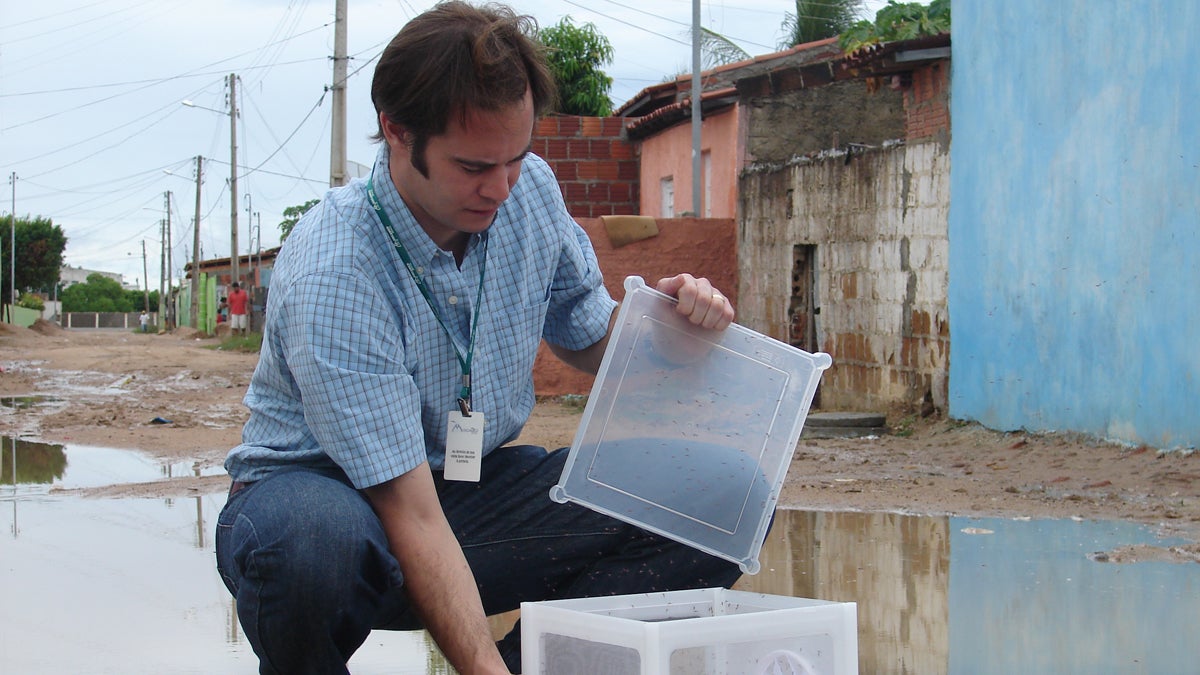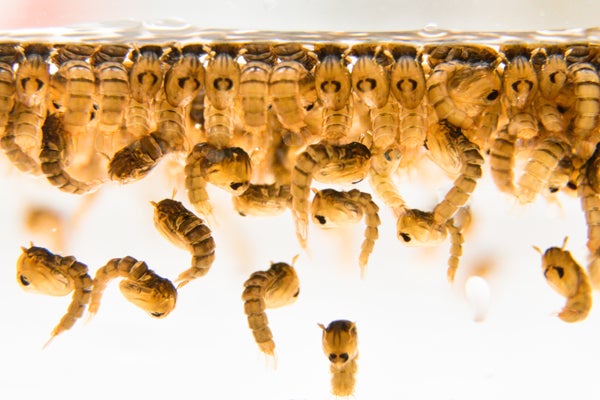Fighting Zika in Brazil by adding more mosquitos?
Listen
Dr Andrew McKemey releasing Oxitec male mosquitos. (Courtesy of Oxitec)
A new front opens in the war against the disease: genetically modified mosquitos.
Under almost any other circumstance, Sarah Mota should be really excited right now. But she’s not.
“Everybody has become so sad and so worried,” she said via Skype from her third floor home in Salvador, Brazil.
Mota is about 12 weeks pregnant, and Zika is on her mind.
Named after the forest in Uganda where it was first identified in the 1940s, Zika is a mosquito-borne virus that scientists suspect has caused scores of major birth defects in the newborns of infected mothers, mainly in northeast Brazil.
Some doctors in the region are going so far as to advise women of childbearing age to postpone pregnancy. This past week, the U.S. Centers for Disease Control and Prevention also issued a travel alert for pregnant women considering visits to 14 countries in the Americas, including Brazil.
Mota, who’s 36, didn’t know about any of this until recently. Now she’s doing everything she can to avoid being bitten by insects that are synonymous with life there…especially in the height of the South American summer.
“I have to watch all the time,” she said, then describing her Zika ‘outfit.’ “I sleep with pants on, and a big shirt and socks. And it’s hot. It’s so hot here.”
A tricky virus
In the last few years, Zika has gone from a very obscure virus in Asia and Africa to one that’s now present in 14 countries in Latin America and the Caribbean. That includes Columbia, Mexico, and most recently, Puerto Rico. Brazil’s Health Ministry estimates more than a million people in that country may have been infected with the virus.
For most people, Zika virus shows no symptoms, or at best really mild ones, like a fever. Mota says her own husband developed a signature rash on his face last year when he contracted it. Now scientists are trying to confirm its link to more than 3,000 cases of babies born with microcephaly, mainly in northeast Brazil. Imagine a normal newborn with an eerily small head, so small it might lack the necessary components for proper brain development.
“I have 35 years in the profession, and I haven’t seen this,” said Dr. Antonio Almeida, a nephrologist and chief of Hospital Geral Roberto Santos in Salvador.
Almeida says panicked moms-to-be are coming to the hospital for extra ultrasounds and monitoring: “It’s something very, very new for us to handle and to metabolize. And at the same time, to help.”
Zika is also thought to be associated with several cases of Guillian-Barre syndrome, a serious nerve condition that can result in paralysis. Almeida said his hospital recently identified eye legions among some newborns they suspect is related, too.
He won’t go as far as discouraging women from getting pregnant, but the hospital did recently set up a surveillance center and is working with scientists like Scott Weaver—a virologist at the University of Texas Medical Branch, who specializes in mosquito-borne diseases—to better track and understand the virus and its spread.
“We think it’s mainly the infected people who transport these viruses around,” said Weaver, who sees its spread amplified in the Western Hemisphere, because it’s so new and the population likely lacks previous immunity. “Probably the vast majority of transmission is human to mosquito to human.”
Weaver says Zika’s link to microcephaly has yet to be totally proven, but the circumstantial evidence continues to grow. The likely suspect is a common mosquito species called Aedes aegypti.
“This particular species…prefer to spend their time inside your home,” said Weaver, adding that their larval habitats can be found right outside in places like flower pots, drinking water containers and accumulated trash containing rain water. “So once they enter, it’s very hard to control them.”
Weaver says this is especially the case in areas of Latin America, where, unlike in the U.S., many communities lack air conditioning and screened windows, putting them in much more constant proximity with mosquitoes.
Rallying a response
Because Zika has been off the map for so long, scientists are now playing catch-up, trying to understand and track it. That’s been tricky because, as Dr. Anthony Fauci with the National Institute of Allergy and Infectious Diseases explains, Zika is closely related to diseases like yellow fever and dengue that are already present in the region.
“The trouble with Zika is that it is so similar to other flaviviruses such as dengue, that in a population such as Brazil, in which dengue is widespread, you have cross reactivity of the [antibody] tests between Zika and dengue,” said Fauci. “So you really can’t tell whether the person has been previously infected with dengue or whether they actually have Zika.”
Fauci also finds the patterns of Zika to be troubling. It follows the sudden appearance of several other mosquito born viruses in recent years that had never surfaced in the Americas: dengue in the 90s, then west nile, followed by chikungunya in 2013.
Human travel has sped up the spread, and warming climates have mosquitoes moving further away from the equator. But as researchers work to improve the diagnostics and treatment for Zika (there is none right now), Fauci says when it comes to vaccine development, “we have a head start on that.”
That’s because scientists are already in the final stages of vaccines for those related viruses, like dengue and chikingunya. He thinks that could give them an advantage against Zika.
Even under the best of circumstances, though, it would still take a couple years for a safe and effective vaccine to get in the hands of someone like Sarah Mota, according Fauci.
Short of a vaccine, interventions are also targeting the mosquitoes themselves. The army has even been called in to some areas of Brazil. Public health efforts are underway to reduce standing water, which is where mosquitoes breed. And health leaders are looking beyond traditional weapons like insecticides to fight the virus’ spread.
A transgenic approach
One idea that’s gaining traction in Brazil is to use mosquitoes to fight mosquitoes. More specifically, these are mosquitoes armed with a deadly genetic twist.
“Well I describe our mosquitoes the same way the press do in Brazil, which is ‘the friendly’ mosquito,” said Hadyn Parry, CEO of the UK-based company Oxitec.
They’re friendly, he says, because they’re male mosquitoes (meaning, they don’t bite humans), but these genetically modified mosquitoes are anything but friendly to their wild, disease-carrying friends.
Over the last decade, scientists at Oxitec, a spinout from Oxford, have been designing transgenic mosquitoes, or rather, genetically modified mosquitoes, that can essentially kill its wild brethren.

Oxitec mosquito larvae. (Courtesy of Oxitec)
The idea is to arm these farm-bred mosquitoes with a self-exterminating gene that can be passed off to other disease-carrying mosquitoes in the wild when they mate and breed.
“So we just release the males, the males go out, they mate with females and those females—their offspring die,” said Parry. “It’s the same sort of science that you would use for producing a genetically modified crop.”
Except in this instance, mosquitoes are getting a gene that gives them a survival disadvantage, not advantage. The idea is if enough of these mosquitoes are released at the right place and time, and on a continual basis, they can help to wipe out the threat of disease-carrying mosquitoes in those targeted areas.
Several small-scale trials of Oxitec’s transgenic mosquitoes have taken place around the world since 2007, marking the first such trials of GM mosquitos in the suppression of mosquitoes, according to Parry. The company is in the final approval stages of commercializing the product in Brazil.
Picture “a normal transit truck” releasing these male mosquitoes through a small shoot out of a window every hundred yards or so.
“You’ll see a puff, and that’s the male mosquitoes being released at certain GPS points,” described Parry. “And then the truck just drives on.”
But much like GMOs in the food supply, the concept has faced some pushback on U.S. soil, where it still needs FDA approval. Last year, a proposal to use Oxitec’s mosquitoes was rejected in an area of Florida that had experienced several cases of dengue fever. People worried about unintended consequences of messing with nature.
Parry likes to think of it as a safer alternative to insecticides, especially on a type of mosquito that likes to hang out near people, in their yards and in their homes. But even he acknowledges, the approach is no magic bullet.
“The battle against mosquitoes is a very continual one,” he said. “We’re not changing that. What we’re just doing is saying, ‘Look. Actually, if you add our tool to the tools that are already there, then actually we’ve got a chance of winning.”
Other scientists are in the early stages of developing transgenic mosquitoes that are unable to carry diseases like malaria, and can then spread that gene into the wild population. Another approach against dengue has involved releasing mosquitoes infected with a bacteria that prevents them from carrying the disease.
Turning to traditional prevention
Back in Salvador, Brazil, Sarah Mota is familiar with Oxitec’s trial, which she estimates is about five hours from her home, and it gives her hope. But she knows such help won’t come soon enough for her; she’s due in early August.
So for now, she clutches one of her biggest weapons—a black bottle with the word ‘Exposis’ printed in bright red on it. It’s the name of an insect repellent so popular, Mota says, that the pharmacies have sold out of it.
“I put [it on] every two hours,” she says. “I put it on again and again. It’s so strong. So strong.”
So strong, she hopes, that it can stave off mosquitoes until her baby is in the clear.
WHYY is your source for fact-based, in-depth journalism and information. As a nonprofit organization, we rely on financial support from readers like you. Please give today.



